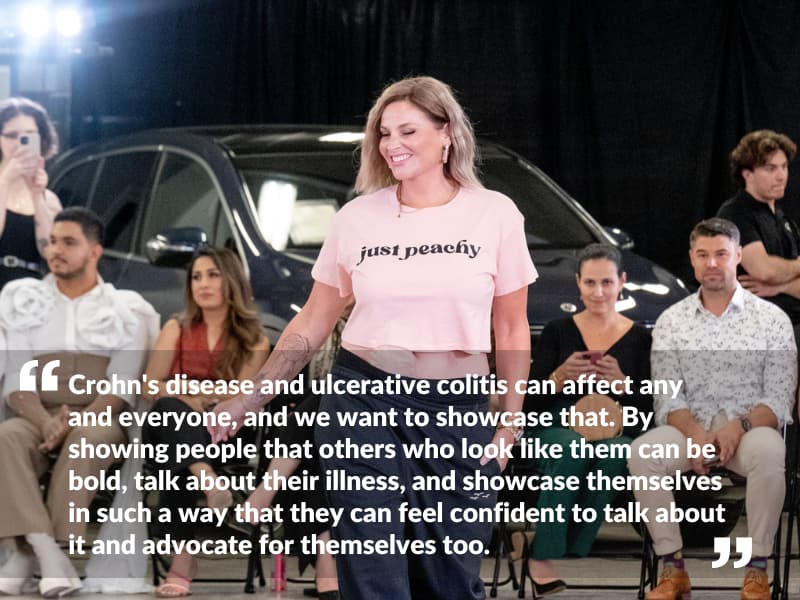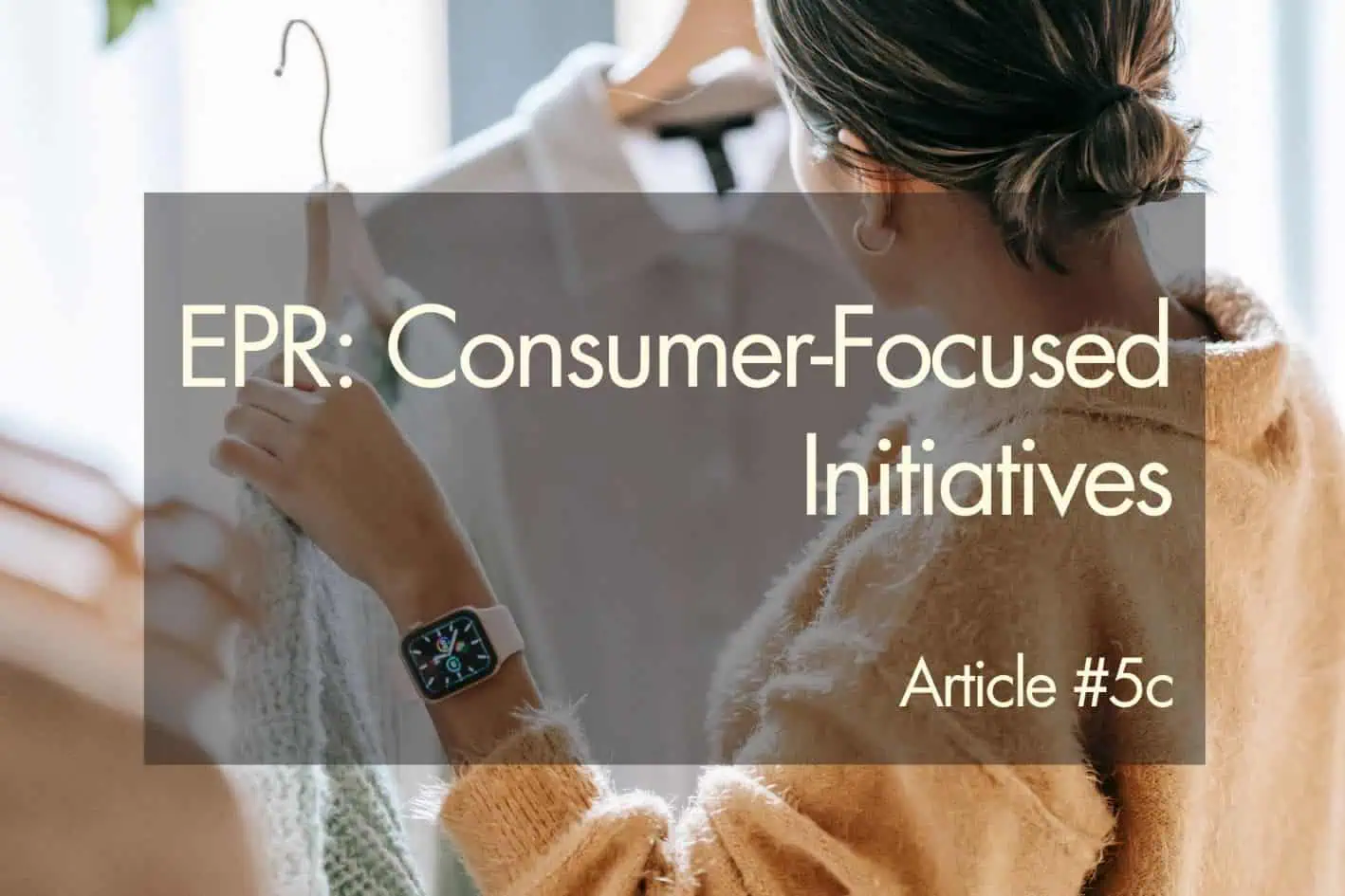Fashioning Hope: Inspiring Change & Creating Awareness with Crohn’s and Colitis Canada
-
Deborah King
- Fashion, Sustainability

Chronic illness affects millions of people worldwide. This article offers a glimpse into the rollercoaster of emotions, frustrations, and triumphs that defined my life as I struggled to get a diagnosis of colitis.
We also explore Crohn’s and Colitis Canada’s innovative efforts to break down barriers and raise awareness through the unlikely intersection of fashion and advocacy as they host the first ever Crohn’s and Colitis Canada Fashion Show. Through an exclusive Q&A session, we explore:
My Diagnosis
In 2016, I was diagnosed with Ulcerative Colitis (UC), a chronic Inflammatory Bowel Disease (IBD) primarily affecting the large intestine (Crohn’s and Colitis Canada, 2024). In 2023, my diagnosis transitioned to Indeterminate Colitis. My understanding is that individuals with longstanding UC may develop complications or changes in their condition that resemble Crohn’s disease. Similar to UC, Crohn’s is also a chronic inflammatory bowel disease, but it can affect any part of the gastrointestinal tract (Hong et al, 2021).
Both diseases are considered autoimmune conditions, meaning the body’s immune system mistakenly attacks its own tissues in the digestive tract, leading to inflammation and a range of symptoms. If the findings are inconclusive or if there are conflicting features that do not align clearly with Ulcerative Colitis or Crohn’s disease, the diagnosis may be labeled as Indeterminate Colitis (Guindi & Riddel, 2004) – as it was in my case.
I first started having symptoms in 2008. Despite confiding in numerous doctors and doing my best to communicate my symptoms, I was continually faced with disbelief and dismissal. I was met with a barrage of invalidating responses:
- I was told I “looked fine.”
- My symptoms were attributed to excessive coffee consumption, despite not drinking coffee.
- Any signs of blood were dismissed as “women’s issues”.
- I was told I needed to think myself better.
- I was laughed at for presenting with too many symptoms.
- I was told it was all in my head, and that it might just be chronic fatigue.
I was suffering daily, but I learned to hide my symptoms as best as I could. Here’s what I was experiencing:
- I was in constant pain – it felt like someone was repeatedly stabbing me from the inside with 100s of tiny knives while wringing and twisting my insides at the same time.
- I would have the urgency to go to the bathroom and there would be an ungodly amount of blood – I became anemic.
- I was tired all the time and felt like I living in a haze.
- My joints particularly in my hands, wrists, and feet hurt.
- I lost a lot of weight when I didn’t have a lot of weight to lose. At one point I weighed close to 90 lbs. I have distinctive, painful, memories of people letting me know I was “too skinny”.
I eventually saw one doctor who recognized that some of my symptoms were similar to his wife’s – he made the referral that changed my life and ultimately got me diagnosed with Ulcerative Colitis. Dr. Vecchiarelli, I cannot thank you enough.
Crohn’s and Colitis Canada
Receiving a diagnosis was merely the first step in my journey. While medication alleviated my physical symptoms, I still needed to heal from the emotional and psychological trauma from years of suffering.
This is where Crohn’s and Colitis Canada played a pivotal role. They offered a wealth of resources to help me understand the implications of my new diagnosis and its long-term effects on my life. I learned how I could maintain physical and mental well-being despite my diagnosis. Through their network, I also had the opportunity to connect with a peer who generously shared her own arduous diagnosis journey and demonstrated resilience in the face of illness. Perhaps most significantly, Crohn’s and Colitis Canada empowered me to start the healing journey and learn about constructive ways to feel like “me” again.
Today, Crohn’s and Colitis Canada is committed to dismantling the stigma surrounding IBD by shining a light on these illnesses. They’re inspiring change by bringing IBD front and center to the runway in the first ever Crohn’s and Colitis Canada Fashion Show!
Check out our exclusive Q&A with Crohn’s and Colitis Canada to learn more…
Fashion with Purpose – Exclusive Q&A with Crohn’s and Colitis Canada
1. Inspiration and Motivation:
Q: What inspired Crohn’s and Colitis Canada to venture into hosting a fashion week event?
A: In 2023, we had the opportunity to partner with an established fashion organization as their charity of choice for their annual event. We hosted an ostomy fashion show where all models who walked the runway, and appeared in our feature live with an ostomy. This event became a big growing up moment for us as we appeared on a larger stage in a different realm than we typically occupy. This year, we’re excited to host the event ourselves and put our own stamp on the initiative to further spread awareness and eliminate stigmas.
Q: How does the organization see the connection between fashion and raising awareness for Crohn’s disease and ulcerative colitis?
A: Crohn’s disease and ulcerative colitis are invisible diseases that people live with quietly and frequently, in secret. By focusing on fashion, something so inherently external and visual, we aim to bring IBD awareness to the forefront of people’s minds and conversations. We want to make IBD visible.

2. Representation and Inclusivity:
Q: How does the fashion week prioritize inclusivity, especially considering the diversity of individuals affected by Crohn’s and colitis?
A: Crohn’s disease and ulcerative colitis can affect any and everyone, and we want to showcase that. By showing people that others who look like them can be bold, talk about their illness, and showcase themselves in such a way that they can feel confident to talk about it and advocate for themselves too. It is incredibly important to our cause that we show the diversity of those living with IBD, and that will be highlighted in this fashion initiative.
Q: Are there efforts to include models, designers, or participants who have a personal connection to the cause?
A: There is absolutely a drive to showcase those models and designers who have a connection to our cause. In 2023, every one of our models was a person living with Crohn’s disease and/or ulcerative colitis, who now lives with an ostomy as part of their disease management. This was a hugely proud moment for us, and for them as it was the first time they were welcomed to show their bag on a public stage, and has inspired and encouraged countless others to do the same. We plan to build on this momentum in 2024 and include even more individuals living with IBD.
3. Fundraising Initiatives:
Q: How will the fashion week contribute to fundraising efforts for Crohn’s and Colitis Canada?
A: The “Shit Show” event itself will be a bold new fundraising event for our organization. We are seeking sponsorships and donors to contribute to the event, and all proceeds from ticket sales will go to support our cause. Every dollar raised goes towards delivering impact as we aspire to fulfill our Promise: to find the cures for Crohn’s disease and ulcerative colitis and to improve the quality of life of everyone affected by these diseases.
Q: Are there specific campaigns or collaborations tied to the event that attendees can support?
A: We will be hosting raw and honest conversations with people living with Crohn’s disease and ulcerative colitis, called “Shit Chats”, throughout the year. We encourage people to join us on Instagram to learn more about these diseases, and how we live with them. The “Shit Show” fashion event will be open to the public, with ticket sales launching in July, and we invite and encourage anyone interested to attend. Keep an eye on our website www.crohnsandcolitis.ca for more details and ticket sales late this summer.

4. Local & Community Engagement:
Q: In what ways does Crohn’s and Colitis Canada plan to engage the community through the fashion week?
A: With our “Shit Show” fashion event open to the public, we hope to engage the local community to attend to enjoy an incredible evening of fashion, support or cause, and learn more about these invisible diseases. The regular “Shit Chats” hosted throughout the year will engage audiences from across the country to join in raw conversations to hear the truth of what it is like to live with a chronic illness. We have an incredible roster of people lined up to share the experiences, and inspire you to know all that you can still achieve. Our aim is to engage our community to be real, raw, and have the courage to share and connect with the countless others sharing in these experiences.
Q: Can you share examples of partnerships with local businesses that align with the organization’s commitment to supporting the community?
A: Partnerships are still in the works, but a few great examples include Lazypants who have been running a “Cheeky Collection” campaign for us for the past year, Crohn’s Colitis Collective who donates all proceeds of their clothing sales to us, and Smash+Tess whose owner Ashley Freeborn is heavily involved in our community and this campaign.
Q: How does Crohn’s and Colitis Canada incorporate local/sustainable fashion designers and brands into the fashion week?
A: We are still working on securing partners for the event, but we are absolutely targeting local brands, and those who run sustainable practices as recognize just how crucial this is.
5. Patient Stories and Experiences:
Q: Will there be a platform for individuals affected by Crohn’s and colitis to share their stories through the fashion week?
A: The Shit Show fashion event is one piece of a much larger year-long campaign coined “Shit Just Got Real”. As part of the campaign, we will be hosting live chats throughout the year with real individuals living with IBD to share their stories, their struggles, and the realities of managing these diseases in every day life. Our goal is to take back the awkward and uncomfortable conversations and create space for people to own their stories in a new and real way.
Q: How does the event aim to create a supportive and empathetic environment for those living with these conditions?
A: This is central to everything we want to create with this campaign. We want to create more understanding and open honesty about living with Crohn’s disease and ulcerative colitis so that people can feel confident to step out of the quiet and own it by seeing other people like them do the same over and over again. These diseases can be very isolating and it’s easy to feel alone when you don’t believe you can share this big and important piece of your life. We want to change that.
6. Educational Components:
Q: Will the fashion week include educational sessions or materials to raise awareness about Crohn’s disease and ulcerative colitis?
A: Absolutely. The campaign will include an educational component through a real life lens. Real people will be sharing their stories of what it is truly like to manage their symptoms, medications, diet and lifestyle. Beyond that, researchers in the field of IBD and experts on both the disease and its management will be sharing important information throughout the year from a more clinical perspective.
Q: How does the organization plan to use this event as an opportunity to inform the public about the challenges faced by those with Crohn’s and colitis?
A: We want to use this campaign and the event to bring IBD to the forefront of people’s minds and shed light on the real life challenges people face. By having real people highlighted both through conversations, and through fashion, we will show the public that we are so much more than their IBD.

Diseases like colitis and Crohn’s are invisible, as you’d never know anything was “wrong” with me, or the over 10 million people worldwide (Khalid, 2022) living with IBD unless we explicitly told you. An unfortunate stigma continues to perpetuate these diseases, which means there could be many more suffering in silence, still undiagnosed.
The question also remains as to why it took over 10 health professionals and 8 years for me to get a diagnosis. I was lucky that the form of colitis I had was considered mild, as this could have been a fatal error. This is one of the many reasons I felt compelled to finally share my story.
By learning more about diseases like IBD and supporting events like the Crohn’s and Colitis Canada Fashion Show you could change and save the lives of millions.
I’m immensely grateful for the amazing work that Crohn’s and Colitis Canada continues to do, and encourage you to check out the Crohn’s and Colitis Canada Fashion Show in September 2024.
Stay informed and learn about more ways to get involved here: https://crohnsandcolitis.ca/Get-Involved

Deborah King
Deborah is a sustainable fashion expert located in Toronto, Canada. She’s an Industrial Engineer with a post-grad in Sustainable Fashion Production. She grew up on the tiny island of Tortola in the British Virgin Islands, and has been sewing her own clothing since the age of 10. She founded Global Measure to help authentically sustainable and ethical fashion businesses stand out from the greenwashing noise through third-party certification.
References
Crohn’s and Colitis Canada (2024). About Crohn’s and Colitis. Retrieved on Feb 14, 2024 from https://crohnsandcolitis.ca/About-Crohn-s-Colitis/What-are-Crohns-and-Colitis
Guindi, M, & Riddell R. H. (Dec 2004). Indeterminate Colitis. National Library of Medicine. Retrieved on Feb 14, 2024 from https://www.ncbi.nlm.nih.gov/pmc/articles/PMC1770507/
Hong, E. H., Jung, J. W., Kim, K. H., Kim, K. J., & Park, E. J. (Jul 1, 2021). Crohn’s Disease with Cutaneous Polyarteritis Nodosa in a Child: A Case Report. National Library of Medicine. Retrieved on Feb 14, 2024 from https://www.ncbi.nlm.nih.gov/pmc/articles/PMC8273316/
Khalid, S. (May 12, 2022). IBD Statistics 2022: Crohn’s and Ulcerative Colitis. Ampersand Health. Retrieved on Feb 14, 2024 from https://ampersandhealth.co.uk/myibdcare/resources/ibd-statistics-2022-crohns-and-ulcerative-colitis/



